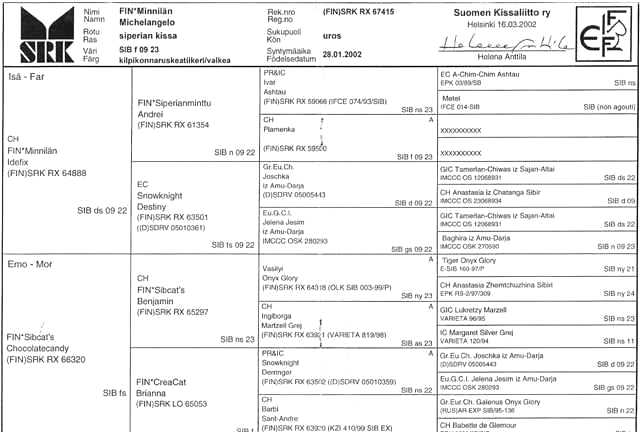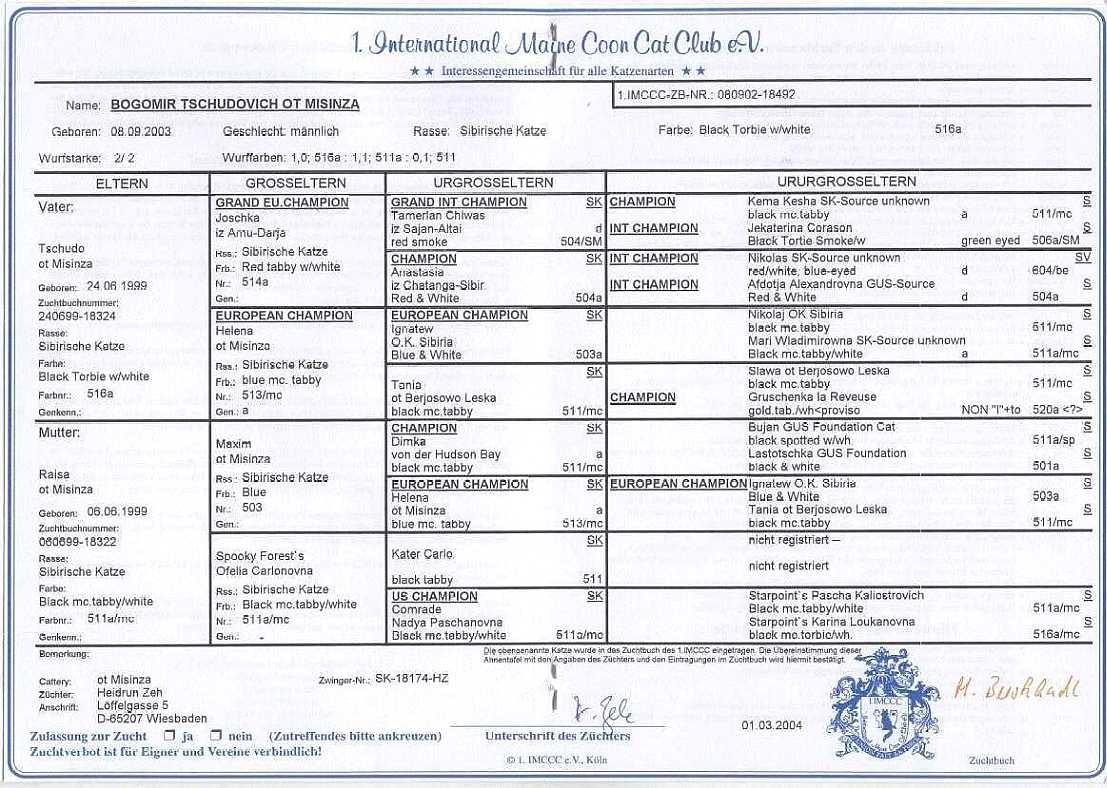|
Joschka, Tschudo's son and Tschudo (the torbie dynasty)
|
Tschudo's torbie son
|
|
|
Tschudo's torbie son
|
A TORBIE DYNASTY?
Conventional genetics states that tortie, calico and torbie (tortoiseshell-tabby) males will not produce tortie, calico or torbie sons. A family of purebred Siberian cats in Germany has produced an unusual number of torbie males, including a torbie male that has sired a further torbie male. Normally if a tortie/torbie male is fertile, he passes on either red or black, but never both. Other related cats have also produced what appear to be torbie males.
Caroline Sharp (Snowknight Siberian Cats, Germany) and Heidrun Zeh (Ot-Misinza Siberian cattery, Germany) have bred a fertile torbie who has sired a torbie son. A torbie grandson arrived in 2006. So far, this is one of only two reported cases of a tortie male siring another tortie male. The initial torbie male is "Tschudo" ("Wonder" in Russian) whose parents are Heidren's blue tabby female "Helena" and Caroline's red-tabby-and-white bi-colour male "Joschka". Tschudo was mated to a black mackerel tabby and white called Raisa and produced 5 kittens, 4 black tabbies and a male torbie. Tschudo's torbie son "Bogomir" (Bogomir Tschudovich of Misinza aka Meli) is mostly white but has big splashes of black, with a big flame of red over and around his ears. With the exception of Joschka, there are no reds in these lines, all the cats are either blacks or blues. Caroline assumed this was just coincidence. Then it turned out that Joschka's daughter Destiny, who had been exported to Finland, had also had a torbie son. Destiny had also been mated to a different male and, via her son, this resulted in a colourful torbie grandson. Unfortunately, both of the Finnish torbie males were neutered and it can't be tested whether they also sire further torbie males.
|
Joschka, Tschudo's son and Tschudo (the torbie dynasty)
|
Tschudo's torbie son
|
|
|
Tschudo's torbie son
|
Tschudo matured slowly and began siring kittens at the age of 5. The vet considered the slow maturation might be related to his unusual colouration. He was shown at a cat Show and he caused quite a stir there as no one had seen a torbie male. He was, of course, in the tortie/torbie class, against all the females.
Tschudo's red-tabby-and-white sire, Joschka, has been mated with a cream tabby female, Desiree, but produced only a red tabby son. Joschka may also be genetically torbie (which would mean 3 generations of torbie males) as he has a few black hairs on his body. However this could be due to lentigo (similar to dark moles) which is fairly common in red cats. Further test matings should reveal whether Joschka sires torbie sons and is carrying some sort of mutation. In theory only creams and reds should result from a red to cream mating. Another mating is planned between Joschka and Desiree, but Desiree had not come into oestrus at the time of compiling this account (Nov 2005).
Caroline had the torbie males blood tested by Prof. Hecht at Geissen University in Germany, but the samples had deteriorated and the chromosome complements of the cats could not be tested. This was an expensive disappointment. She contacted Leslie Lyons at Davis, California, but there was no way to conserve the blood long enough for it to be tested. At present the tests aren't being repeated due to the stress of taking the blood samples
|
Michelangelo, the colourful torbie male from Joschka's line
|
Tschudo was also mated to another female and there is a possibility that two more males in that line may also be torbies rather than tabbies. In due course a daughter or sister of Tschudo will also be test mated to see if torbie males result. Caroline's friend, will also try a mating with either a daughter or sister from Tschudo and see if this will be passed on; one of those females has produced 2 males that may also be torbies though their markings make it difficult to be certain. In due course they will be test-mated, but Tschudo's slow maturation rate suggests this may be later rather than sooner.
I initially wondered if it was possible that the females have a genetic difference that affects how they carry their embryos, making them more likely to have chimeras (fused embryos) than usual. However, the females involved are from different lines. A family connection is Joschka and his daughter who have produced the torbie son and grandson.
I've never seen a pedigree with more than one torbie (or tortie/calico) . If 3 generations of definite torbie males occur, the story should go to a scientific or veterinary journal as it turns all the current theories upside down!
This pedigree is for Michelangelo (f 09 23), a black mackerel tabby tortie with white.

Key to FIFe colour codes in Michelangelo's pedigree:
|
n = Black/normal/ruddy/seal |
f = Black Tortoiseshell |
09 = Unspecified amount of white |
In July 2005, Bogomir also proved fertile. The mating was an accidental one with his own mother, Raisa. It resulted in 3 female kittens born on the 25th July. The kittens resemble their father, two being black tabby bi-colours and the other being white with black tabby on the head and tail. Two year old Bogomir was the only male present that carried white spotting and had remained with his mother as it was assumed he would not become fertile at 2 years, if at all. Bogomir's torbie father had not proven fertile until the age of 5 years. Sadly, two of the kittens sired by Bogomir (Meli) did not survive. This seemed to be due to depressed immune systems resulting either from inbreeding or associated with the torbie male condition. However it proved Bogomir's fertility and a mating with an unrelated female is planned.
Pedigree of Bogomir Tschudovich of Misinza

More information can be found at http://www.snowknight.de/
under the tab "Torbie Males".Bogomir, torbie son of torbie father, Tschudo, sired a torbie male kitten born 20th May 2006. Unfortunately Bogomir had mated with his sister who is prone to going into oestrus silently. The torbie kitten was nicknamed "Muti" and though small is doing well. After almost 2 years of trying to get anyone interested in looking into the phenomenon, Leslie Lyons in the USA is investigating. There is a possibility of a new gene mutation that is causing the red colour to be inherited in a non-sex-linked way (not on the X chromosome).
In 2013, more and more "torbie" Siberian Cats were turning up. Most had close Polish ancestry and were silver tabbies, but the effect was otherwise very similar to the cats described above. The effect bore some resemblance to an incomplete amber colour-change in Norwegian Forest Cats. These were nicknamed "bimetallic" cats as they combined silver-tabby and golden-tabby areas. They are described and illustrated at "Bimetallic" Siberians. It is not yet known if these are related to Joschka or one of his relatives.
MULTIPLE GENERATIONS OF PERSIAN TORTIE MALES
Nicoletta Locati is an Italian breeder of Persians. She has a fertile tortie male whose daughter produced a blue tortie (blue-cream) male in 2008. In addition, another kitten (sold in December 2007) turned out to be a blue tortie male when judged at a cat show. Nicoletta has contacted Dr Leslie Lyons in the USA (involved in the Snowknight tortie dynasty) and is planning some tests.
MULTIPLE GENERATIONS OF NORWEGIAN FOREST CAT TORTIE MALES
The "Tripple" line of Norwegian Forest Cats apparently produces fertile male calicos at least every third generation. The foundation male of this line was a fertile calico male called Tripple. Tripple had a black patch on his flank which may be a somatic mutation, but otherwise appears to be a red/white bicolour. Some of these calico toms could be seen at Dutch cat shows. They look like ordinary red or red bicolour males, but have small black spots - these spots are very definitely black, not merely dark red. Some also had a mix of red and black in their coat, with the red always predominating. Studies of pedigrees from Tripple's breeding line indicated that calico males occurred every third generation and sometimes as often as every second generation. There was apparently a distinct ratio of calico males which certainly merits a more detailed study of the phenomenon. Initial studies, based on phenotype rather than genotype, showed no evidence of XXY (Klinefelter) in the line.
TORTIE SPHYNX FATHER AND SON
Sandi Keeler in the USA has also had a second generation tortie male. In this case the tortie males are Sphynxes and both father and son are fertile.